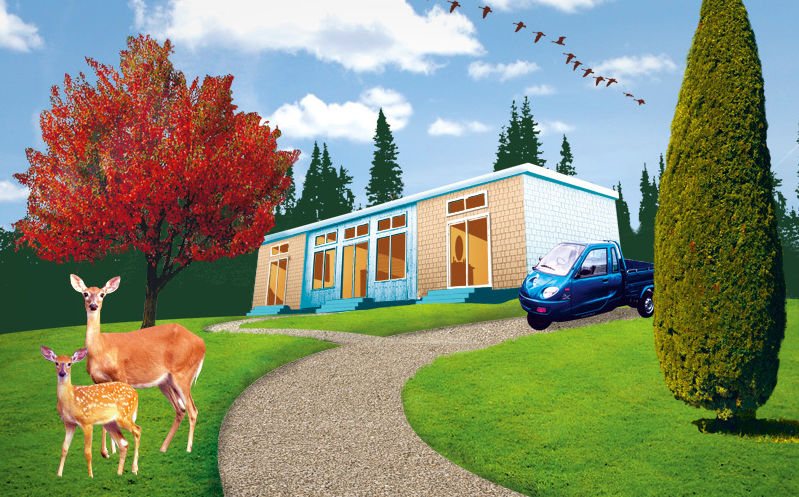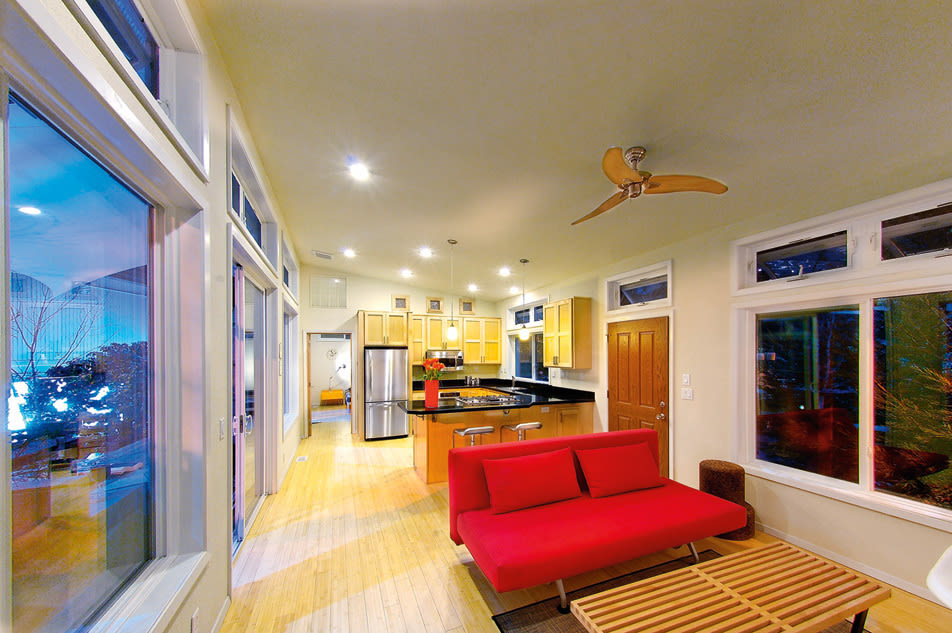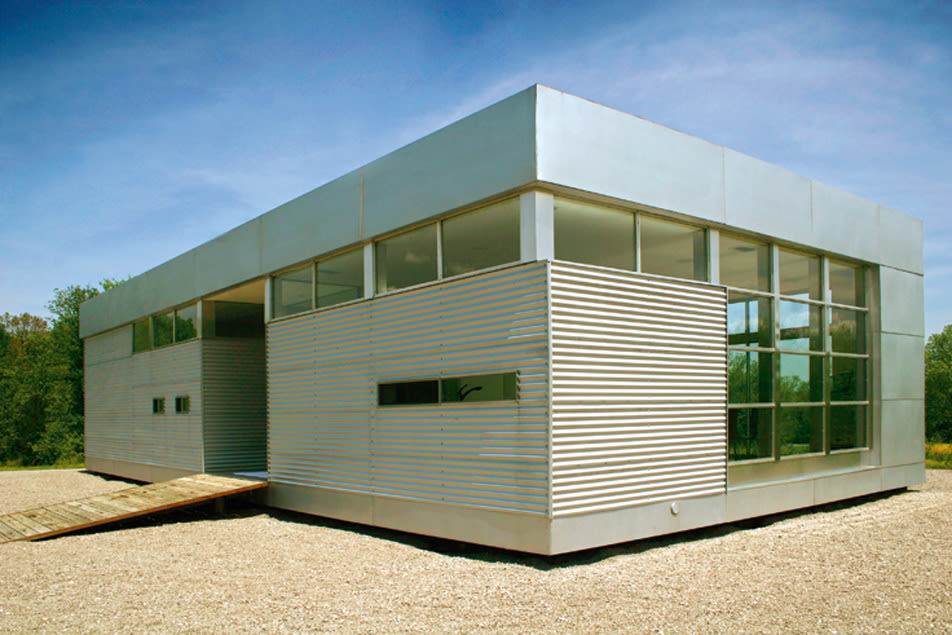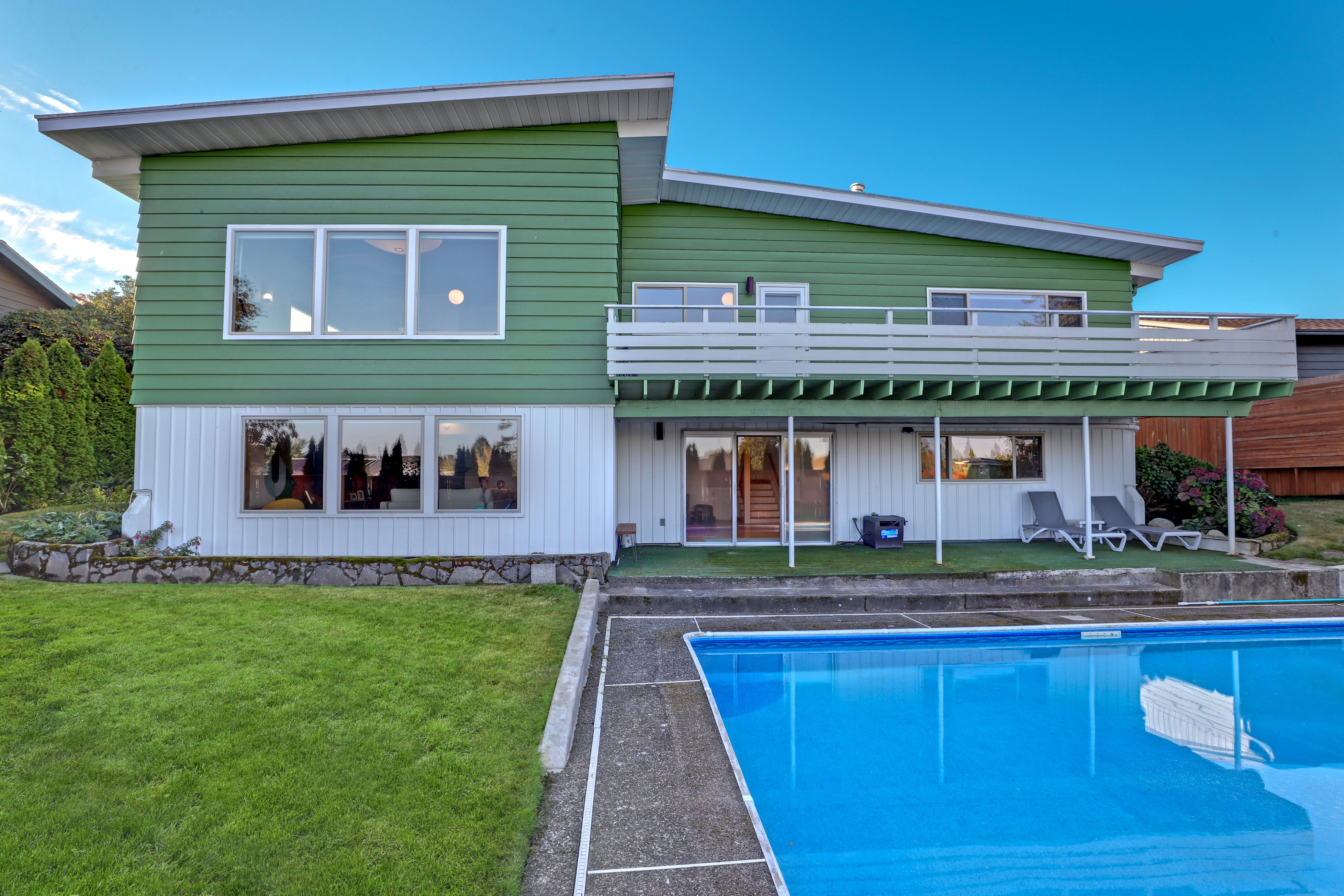Prefabulous

A rendering of the Murrays’ Ideabox (deer not included)
Image: Thomas Cobb
A simple, flat-roofed box sits as a modern version of a humble country idyll atop a hill on Patrick and Celia Murray’s land. Eventually the Vancouver couple will build a much bigger house on their 85-acre retirement plot in Polk County, but in the meantime the two-bedroom, 840-square-foot cottage, which is almost ready for move-in, seems eminently livable. With its airy plan, gleaming finishes (such as maple cabinetry and bamboo floors), and tall windows overlooking valley vineyards, it’s certainly more appealing than the standard temporary housing option: a single-wide.
Except that it is a single-wide. Note the 15-foot-wide floor plate and the steel chassis underpinning. Built on a factory assembly line and hauled on removable axles to its foundation, the Murrays’ house—the brushed-nickel bathroom fixtures notwithstanding—is, by its rightful name, a manufactured home. Its creator, Salem entrepreneur Jim Russell, calls it the Ideabox.
The slick little Oregon-made house is an intriguing new entrant in the longtime quest to mass-produce haute-design prefab housing. In the first half of the 20th century, architects began dreaming of harnessing the power of factory production to create sleek, modern homes that working-class families could afford. But futuristic visions like Le Corbusier’s cubelike 1914 Maison Domino and Buckminster Fuller’s circular 1940s Dymaxion House never got far from the draft stage, doomed by conservative popular taste and (more so) by the architects’ unfeasible production schemes. Instead, the prefab-housing industry bloomed under the leadership of profit-motivated home builders whose cheap, pseudo-traditional houses found a ready market—despite having all the visual grace of shoe boxes. By 2007, factory-built housing accounted for more than 10 percent of the single-family-housing market.
And that might have been the end of the story. But a few years ago, spurred, arguably, by advancements in design technology and a resurgent interest in midcentury-modern architecture, the image of the prefab home as an icon of stylish modern living re-emerged. Such design-minded magazines as Dwell and Sunset introduced their own models in 2005, and today the Dwell Home and the Sunset Breezehouse have been joined by the weeHouse, the Kithaus, the B-Line, the Skyline, and a seemingly endless stream of pithily named, architect-designed living spaces that can be assembled at a plant and delivered to your door. The Museum of Modern Art in New York City even mounted a show last summer to tout the past and future of prefab architecture, going as far as erecting five cutting-edge structures in its own courtyard.

A model of an Ideabox living room, as shown at this year’s Portland Home & Garden Show
Image: Thomas Cobb
When the Murrays started looking for an inexpensive manufactured home to put on their property—“the quickest thing we could put out there that would make us happy,” Celia says—their choices seemed pretty bleak. On one end were standard single-wides and double-wides, like those sold on industry leader Palm Harbor Homes’ model lot. There, a three-bedroom, 1,188-square-foot Ritz I retails for $49,995, including wall-to-wall carpet, appliances, and fake plastic columns flanking the optional bay window. It wasn’t what the Murrays had in mind, and when they asked whether the interior finishes in some inexpensively built homes release harmful chemicals such as formaldehyde—a common concern in the wake of Hurricane Katrina—they got no answers.
Then there were high-end, architect-designed products like those named above. The Murrays liked the look of the Glidehouse, an elder sister to the Sunset Breezehouse designed by Bay Area architect Michelle Kaufmann, with its open-plan living area, walls of sliding glass, natural wood exterior, eco-friendly no-VOC paint, and sustainably harvested bamboo floors. But at $250 per square foot, it was well out of the Murrays’ price range—comparable, in fact, to having a house custom-designed and built on-site. (A note about pricing: For obvious reasons, the cost of a factory-built home doesn’t include building the foundation; hooking up water, sewer, and electrical lines; and paying for local inspections. The Murrays estimated those costs would add about $40,000 to their prefab home. If you wanted to erect one on an empty lot in Portland, you’d also have to buy the land.)
Then Patrick and Celia discovered the Ideabox. Yes, the siding is corrugated metal and fiber cement rather than natural wood, but inside is a smartly designed living space: two bedrooms, two baths, a spacious kitchen, and a tiny living area arranged in enfilade, allowing for long sight lines and no space-wasting corridors. Big sliding glass doors open onto a deck (sold separately) to bring in natural light and the sense of extra space.
Company founder Russell, a former residential energy-efficiency analyst with the Oregon Department of Energy, saves costs partly by contracting with a Salem plant that churns out the same kinds of standard mobile homes you find on lots like Palm Harbor’s. So the Murrays’ 840-square-foot Confluence Modern model (there’s also the 400-square-foot Northwest Modern and the 625-square-foot Island Cottage) comes at a manufactured-home price of $85,000—less than half the per-square-foot cost of a Michelle Kaufmann home.
In other words, the Ideabox comes remarkably close to achieving that mix of efficient design, honest structural expression, and affordability that has long been the ideal of modern architecture. So far, counting the Murrays’, Russell has sold 14 houses. It may not seem like much, but it’s a start.
The dream of beautiful, high-quality prefab housing became a reality in countries such as Japan and Austria years ago, but most Americans still associate manufactured homes with “trailer trash” and feeble, retrograde design. That image has been changing, thanks to a recent wave of forward-looking prefab homes created by ambitious young American architects. Here’s a sampling of the more intriguing products to emerge—all of which can be shipped to Portland.

An exterior view of Rocio Romero LLC’s minimalist and modern prefab homes
Image: Richard Sprengler
LV HOMES
Made by: Rocio Romero LLC (Perryville, Missouri)
Number sold: 64 since 2004
Clustered in: California, New York
Example: Two-bedroom Standard LV
Square feet: 1,150
Cost of kit: $35,923
Cool points: Rocio helped launch the modern prefab craze with this minimalist modern shack enveloped in no-nonsense galvanized steel and floor-to-ceiling glass. It’s still a market leader.
Buyer beware: This is a kit home; the factory will ship you a set of plans and the major structural components—then you hire a general contractor to assemble the parts and add interior finishes at an additional estimated cost of $100,000 to $188,000.
Find out more: rocioromero.com
MKD PORTFOLIO SERIES
Made by: Michelle Kaufmann Designs
(Oakland, California)
Number sold: 34 since 2002
Clustered in: California
Example: Two-bedroom Sunset Breezehouse
Square feet: 1,800
Cost: Approximately $500,400
Cool points: This eco-friendly, modular dream house exemplifies the casually classy, indoor-outdoor lifestyle made famous by corporate sponsor Sunset magazine.
Buyer beware: Built for style and comfort, this isn’t the answer for cost-conscious consumers. But at least Oregonians will save on shipping, since the plant is in Washington.
Find out more: mkd-arc.com
WEEHOUSE
Made by: Alchemy Architects (St. Paul, Minnesota)
Number sold: 20 since 2002
Clustered in: New England, Montana, Oregon
Example: Tall Two-Bedroom
Square feet: 1,176
Cost: $199,000
Cool points: Whereas some modern prefab manufacturers promise to reinvent your lifestyle, this firm just sells easygoing, utilitarian houses that are as affordable as they are customizable.
Buyer beware: You may feel overwhelmed by the data-driven sales pitch and the seemingly endless options for assembling the basic modules into a complete house.
Find out more: weehouse.com
*Costs don’t include variable fees for customizing, shipping, and “buttoning up” the factory-built modules once they arrive—which, when added up, may exceed $125,000, depending on the project.




